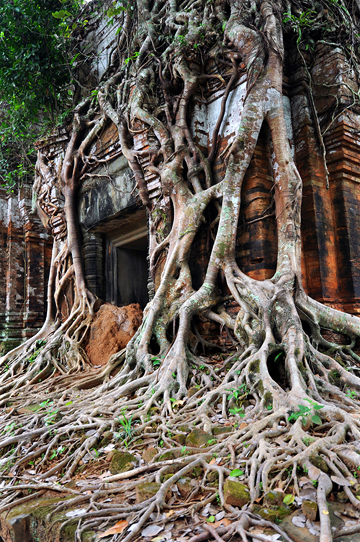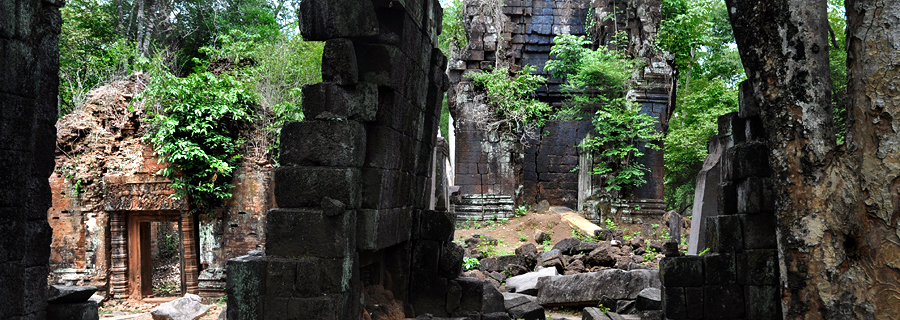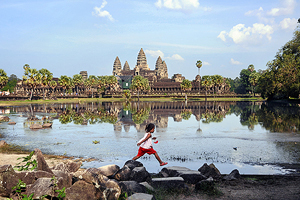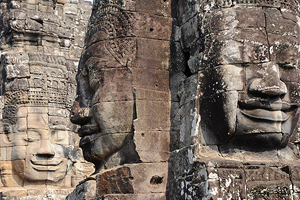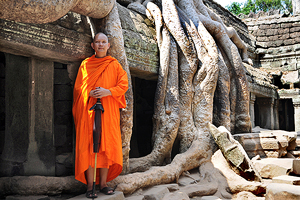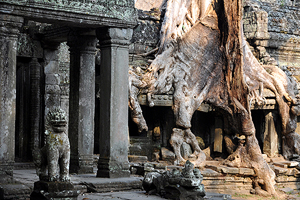Koh Ker temples |
|
Compared to earlier examples, many sandstone towers in and around Prasat Thom are of enormous size and, besides Phnom Bok in Angkor, sheltered the largest Lingas known in Cambodia. The French archaeologist Lunet die Lajonquière came to the conclusion, that, given the limitations of Khmer constuction techniques, the use of wooden carpentry had to be extended in Koh Ker.
A characteristic of both architecture and the sculpture of Koh Ker is the use of huge blocks of stone. Sandstone was abundantly available in this area and, compared to Angkor, there was less of a problem in moving it. Nevertheless, brick still predominant as material, but the use natural stone, sandstone and also laterite, was increasing. Square ground plans were the most common, but rectangular buildings occur more often than in previous periods, from now on not only for galleries, but for libraries and other kinds of edifices, too. In particular, the evolution of galleries, only hinted at in earlier periods, makes some advance at Koh Ker’s principal temple Prasat Thom, both in the almost continuous series of gallery buildings of its second enclosure and in the uninterrupted semi-open column hall of Prasat Thom's exterior gate. The arrangement of towers in quincunx, which began at the Bakheng and became a favourite pattern for some time was less predominent in Koh Ker, however, it occurs at Prasat Krachap. All the monuments in Koh Ker are dedicated to Hindu deities, mainly Shiva. Remarkably, there are no shrines for the Buddha. This is in contrast to earlier and later periods of Khmer history, when the Buddha, besides Shiva and Vishnu, used to be venerated as one of the three most important supernatural beings “imported” from India - despite the fact that in this country of origin the Buddha was regarded as unorthodox or even heretical by devotees of Shiva and Vishnu. |
strangler fig at north-western tower of Prasat Pram,
more on our page Southern Group |
Koh Ker maps
|
Temple Groups
The temples of Koh Ker can be considered in three groups.
1. the ruins of the fortified capital with the main complex of Prasat Thom and the pyramid Prasat Prang to north of the Rahal reservoir 2. a row of temples to the north and east of the Rahal Baray is oriented to it, all of them located at the eastern part of the ring road circling around the city reservoir 3. some more smaller Prasats to the south of the Rahal and oriented regularly to the east, many of them with enclosing walls Prasat Damrei and neighbouring large temples are usually ascribed to the northern group, but some guidebooks and websites count them among the southern temples. most important temples
Prasat Thom is Koh Ker's largest temple compound. Prasat Thom in a narrow sense is only a part of the whole complex of the imperial temple, namely the concentric temple with three enclosing walls and a wide moat. To the east of it is the gate called Prasat Krahom and the so-called palaces. Immediately to the west of the core temple Prasat Thom is the step pyramid, landmark of Koh Ker, and the artificial mound called tomb of the white elephant.
Prasat Balang at the northern end of the northern temple group is a good example among five quite similar Linga shrines. The Lingams inside these temples are of enormous size. Prasat Krachap is one of the four larger complexes of the northern group. Prasat Krachap has well-preserved inscriptions,for example at the western entrance gate. Prasat Banteay Pirchan (Banteay Pee Chean) is the only Khmer temple complex dedicated to Brahma, who is part of the so called Trimurti of highest Hind gods. This is one of the most picturesque ruins of Koh Ker. Prasat Chrap has a typical row of three Prasats. Prasat Damrei is famous for its elephant and lion sculptures. Prasat Neang Khmau is built o laterite, the stone became bluish and dark due to oxidation. Prasat Chen (Chin) got its name "chinese temple" because of the queus of hair of remarkable statues found here, Koh Ker's "fighting monkeys" are now on display in the National Mueseum in Phnom Penh. Prasat Pram (Bram) is the fairy tale temple of Koh Ker, the roots strangling the north-western Prasat are like in a picture book of a temple lost in the jungle, see it on the photo above or as the title photo of this website. Koh Ker history Even before Jayavarman IV became king and Koh Ker the new capital in 928, he had started an ambitious building programme in his residential town, which had been a powerful provincial city already rivalling Angkor. Since the Khmer kings in Angkor remained childless, Jayavarman IV, who was a son of their aunt Mahendradevi and married with another aunt of them, may have been a legitimate successor, not an usurper, all the more so as the maternal line played a more important role in Southeast Asia. Jayavarman had already contested the rule of his cousins during their reign in Angkor. In 921 he had placed the largest Linga of Khmer history on top of the until then highest pyramid in Cambodia. Lingapura, “Linga town” became the name of Koh Ker, which is the name of the modern village. In inscriptions, the ancient city was mostly called Chok Gargyar, “city of brightness”. They mention collection of taxes and compulsory labourers from far away provinces. When Jayavarman IV died in 941, his younger son, who was not the designated heir to the throne, succeeded him as Harshavarman II, due to the help of a mighty cousin. When the new king died in mysterious circumstances after only two years, this cousin seized power. This mighty King Rajendravarman II decided to shift the capital back to Angkor. Only few temples were built in Koh Ker after the reign of Jayavarman IV, the last one was a chapel of a hospital built by the first Buddhist Khmer king, Jayavarman VII. Read more about Koh Ker’s history here... |
|
Prasat
Banteay Pee Chean, the only Khmer temple complex dedicated to Lord Brahma, more on our page Northern Group... |
